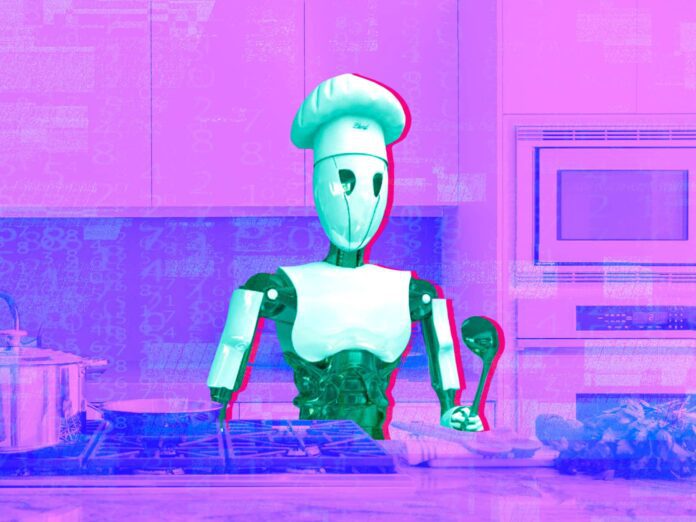
The culinary world is embracing many innovative technologies. Regarded as impossible a couple of years ago, it is now common knowledge that there are robot chefs that can perform a number of kitchen-related tasks such as stirring fries and pasta, flipping burgers, and assembling pizzas. Today, AI robot chefs can actually do more. With the aid of onboard sensors, optical cameras, and enhanced AI technology, these AI robot cooks are fundamentally designed to multitask, executing the actions and movements of professional human cooks in real time.
What Is an AI Robot Chef?
In simple terms, an AI robot chef is an AI-enhanced robot that is designed to cook food. One of the latest AI robot chefs, Moley Robotics, is the world’s first fully robotic kitchen and acts as an AI autonomous system that can automate virtually every part of the cooking process. It is a ceiling-mounted device that works in conjunction with an entire smart kitchen. With its two arms, it glides along a track fitted in the ceiling and is able to adjust temperatures, use the sink, mix and pour ingredients into pans, as well as stir pots. Pre-programmed with recipes, Moley Robotics can cook over 5,000 meals at a time and clean up when it is done.
These robots can learn how to make food through the aid of the sensors attached to kitchen utensils which serve to analyze recipes. They are also able to monitor more than 1,200 parameters every microsecond and can touch, smell, see, and hear. These sensations send feedback to their Operating Systems (OS), creating a learning loop similar to that of a human being. With the help of these features, they can automate many kitchen tasks and learn new skills over time. AI robot chefs have tactile, contact, and proximity sensors for recording tasks, capturing movements, and cooking recipes. This allows the robots to decipher when ingredients need replacing, suggest dishes, control calories, and adapt the menu to different diets and lifestyles. The AI robot chef is able to teach itself and perform these tasks by storing information in its database and retrieving it whenever the need arises.
There is every indication that the 21st-century world seems ready to welcome more of the innovative technologies of AI robot chefs, as experts predict that there will be 482.8 million smart homes by 2025. It is also estimated that the global human population will hit 8.0 billion before the end of 2022. This will trigger an increase in food demand, pressure on the global food industry, and a call for better and sustainable food quality by consumers. This is where the AI robot chef comes in handy.
Benefits of AI Robot Chef
#1: Solves Understaffing
AI robot chef solves the problem of understaffing for most restaurants, fast food, and high-volume kitchens by complementing or taking over the job of human beings, thereby reducing cost and enhancing customer experience.
#2: Reduces Waste
By dispensing the required ingredients for each meal, AI robot cooks help to reduce food waste and costs through the elimination of human error arising from over-estimation. In addition, advanced AI robot chefs can monitor and control the environment of food storage containers to avoid spoilage of ingredients.
#3: Smart Kitchen Collaboration
Smart kitchens are now commonplace in most homes and they come with automated features and semi-autonomous appliances needed for the AI-enhanced robot chef to function effectively. This reduces the time human cooks spend in the kitchen.
#4: Contamination Reduction
AI robot chefs serve to eliminate the risk of contamination arising from foodborne illnesses. They also encourage savings, increase business profit, and enhance customer satisfaction and loyalty.
Limitations of AI Robot Chef
The AI Robot Chef is unable to deal with the preparation of ingredients and food items for cooking, such as peeling a potato or garlic, dicing carrots, and cutting vegetables or fruits. AI robot chefs are very expensive at the moment which makes many people unable to afford them. Human beings naturally enjoy cooking and trust eating their food so, it is largely unlikely that AI robot chefs will replace human cooks completely and may instead act as an assistant.
Future Path
Researchers at Cambridge University have created an AI robot chef that can taste the food at different stages of the chewing process. While this is an ongoing project, the desired result would be an AI robot chef that can chew anything, applying its enhanced sense of taste in the process. In addition, AI robot chefs would need to have improved taste receptors to be able to have the five basic taste modalities of sweet, sour, salty, bitter, and savory.
There is still the need to evolve an AI robot chef that would better integrate detailed data as it is received into its OS, in order to ensure greater flexibility, enhanced operation, and improved outcome. Online Robotic Ghost Kitchen promises to be the next big thing and will make it possible for people to create their menus and recipes and order their meals online. These AI robots would prepare the recipe according to the given specifications and have them delivered to their customers in record time.
Overall, the golden era for technological advancement in the food industry seems to have arrived. Though this advancement has suffered some delay, there is hope that the global acceptance predicted to accompany the AI robot chef system will make up for its many years of development.
- SEO Powered Content & PR Distribution. Get Amplified Today.
- Platoblockchain. Web3 Metaverse Intelligence. Knowledge Amplified. Access Here.
- Source: https://www.iotforall.com/ai-robots-chefs



